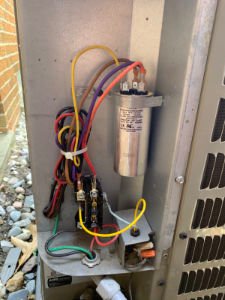Ever wondered why your AC might not be cooling as it should? It could be due to a small part called the AC capacitor.
Think of it as the little engine that helps your AC run smoothly, especially during those scorching summer days. But like all things, capacitors can falter; when they do, it’s essential to diagnose the issue promptly.
You can easily test an AC capacitor with a multimeter by yourself. Let’s unpack that.
In this article, we’ll walk you through how to do just that with a digital multimeter and voltage meter.
So, let’s dive in and get your Air Conditioner back to its cool self!
What Does a Capacitor Do?
The capacitor is like a mini battery. But instead of storing energy for a long time, it saves up energy quickly and releases it all at once. This quick burst of energy helps things like your camera flash light up instantly. So, in simple words, a capacitor is a tiny energy booster inside many of our everyday electronic items like Air conditioners, Fans, Lights, etc.
Types of AC Capacitors

Did you know there’s more than one type of capacitor? And they fall under two categories: start capacitors for compressors and run capacitors for fans, blower motors, and compressors.
Let’s dive into the different kinds:
Single Run Capacitor
This is the simple guy. Found mostly in furnaces and smaller HVAC systems, it has two terminals and powers just one motor. Think of it as the basic capacitor that does its job without any fuss.
AC Start Capacitor
The name gives it away. This capacitor’s main job is to give your compressor a quick start. It’s like the jolt of energy your AC needs to get going. And there’s a special kind called the Super Boost Capacitor, which comes with a built-in potential relay.
Dual Run Capacitor
This is a two-in-one deal. It’s like having two capacitors in a single package. It runs continuously and has three terminals on top. You’ll find these in premium HVAC systems as they support both the compressor and fan motors.
Symptoms of a Bad or Failing Capacitor

When your AC isn’t acting right, it might be pointing to a problem with its capacitor. Here are some easy-to-spot signs that your AC’s capacitor might be on the fritz:
- AC Not Blowing Cold Air: If your AC isn’t cooling your home like it used to, it could be a capacitor issue. If you’ve tried turning it off and on again and it’s still not cold, it’s time to call in the pros.
- High and Rising Energy Bills: Noticed your energy bills going up? A failing capacitor might be making your AC work harder than it needs to, using up more energy.
- Humming Noise: When you turn on your AC, listen closely. If you hear a humming sound or if it seems hesitant to start, the capacitor might be the culprit.
- Old HVAC System: Like all things, capacitors age. If your AC system is old and sometimes refuses to turn on, the capacitor might be worn out.
- AC Turns Off On Its Own: If your AC has a mind of its own and shuts off randomly, it could be signaling a capacitor problem.
- AC Doesn’t Turn On Immediately: Does your AC take its sweet time to start after you’ve turned it on? This delay can be a sign of a bad capacitor.
AC Won’t Turn On At All: If your AC doesn’t want to start up at all, a completely failed capacitor might be the reason.
Steps to Test an AC Capacitor with a Multimeter
If the AC Capacitor malfunctions, your AC might not work efficiently, or worse, not at all. But how can you determine if the capacitor is the culprit? Let’s walk through checking an AC capacitor with a multimeter step-by-step:
1. Turn off the Power to the AC Unit
Safety first! Before you start, turn off the power to your AC unit. This can be done by switching off its disconnect or its circuit breaker. To be extra safe, consider turning off both. Use a multimeter or a non-contact voltage tester to confirm that the power is indeed off.
2. Access the Capacitor
Locate the AC’s electrical panel cover, usually found on the side of the unit. Using a socket set or a nut driver, remove the screws and open the panel.
Once open, snap a quick photo of the old capacitor, focusing on the wiring. This will be a handy reference if you need to replace it.
3. Disconnect the Wires
Before disconnecting, note the wire colors and their corresponding terminals. Use needle-nose pliers to gently remove the spade connectors from the capacitor terminals.
4. Discharge the Capacitor
This step is crucial for safety. Using a long metal screwdriver with an insulated handle, short the capacitor’s terminals. Hold the screwdriver by its handle and touch the metal shaft to each terminal, discharging any residual energy.
Remember, only touch the insulated handle during this process.
5. Test the Capacitor Using a Multimeter
Now, it’s time to test!
Using the Capacitance Function:
- Turn on your multimeter and set it to the capacitance function.
- Check the capacitor’s label for its rated capacitance (e.g., 20uf means 20 microfarads). If it’s a dual run capacitor, it’ll have two ratings.
- For the condenser fan: Place one probe on the “C” (common) terminal and the other on the “FAN” terminal. Wait for a few seconds, and the multimeter should display the capacitance reading. A good capacitor will have a reading within 10% of its labeled specification.
- For the compressor: Place one probe on the “C” (common) terminal and the other on the “HERM” terminal. Again, a good reading will be within 10% of the labeled specification.
Using the Resistance (Ohms) Function:
- Turn on your multimeter and set it to the Ohms function.
- For a quick ohm reading: Place one probe on “C” and the other on “FAN”. The reading should jump and return to infinity ohms. Reverse the probes and check for the same behavior. Repeat this for the “C” and “HERM” terminals.
- To check for a bad capacitor: Place one probe on “C” and the other on the capacitor’s outer metal casing. If there’s a reading indicating continuity, the capacitor is faulty. Repeat this for the “FAN” and “HERM” terminals.
Special Cases – Capacitors with Resistors: Some capacitors have a resistor bridged across their terminals. If you encounter one, detach the resistor before testing. If the resistor is soldered, desolder one end to isolate it from the capacitor’s circuit. After testing, remember to reconnect or resolder the resistor.
6. Interpreting the Results
Compare the multimeter’s reading to the rating on the capacitor’s label. For instance, if the label says “20uf ±6%”, the reading should be between 18.8 and 21.2uf. If you’re testing a dual run capacitor like “45+5uf ±6%”, the compressor side should read between 42.3uf and 47.7uf, and the fan side between 4.7uf and 5.3uf.
If the measured capacitance is out of the specified range, it’s time to replace the capacitor. Even if it’s slightly off, consider a replacement to ensure optimal AC performance.
If the capacitor is in good shape, reconnect the wires as they were. If it’s faulty, replace it with a new one, ensuring the wires are connected to the correct terminals.
How to Replace an Air Conditioner Capacitor

Replacing an air conditioner capacitor is a task that might seem daunting, but with the right tools and a bit of guidance, you can handle it yourself. Here’s a step-by-step guide to help you through the process:
- Safety First: Always start by turning off the power to your air conditioner. This can be done at the circuit breaker or the disconnect switch located near the outdoor unit.
- Access the Capacitor: Open the service panel on your air conditioning unit. This is typically secured with screws, so you might need a screwdriver or a socket set.
- Document the Setup: Before you disconnect anything, take a clear photo of the capacitor and its connections. This will be invaluable when you’re reconnecting the new capacitor.
- Discharge the Capacitor: Capacitors store energy, so you’ll need to discharge it to avoid a shock. Using a metal tool with an insulated handle, like a screwdriver, place it across the capacitor’s terminals. This will create a short circuit and discharge the capacitor.
- Disconnect the Old Capacitor: Using needle-nose pliers or a similar tool, gently disconnect the wires from the capacitor. Remember to be gentle to avoid damaging the connectors.
- Install the New Capacitor: Position the new capacitor in the same spot as the old one. Using the photo you took earlier as a reference, reconnect the wires to the appropriate terminals.
- Secure the Capacitor: Ensure the new capacitor is securely in place. Some units might have a retaining bracket to hold the capacitor, so make sure it’s fastened properly.
- Close the Service Panel: Once everything is connected and secure, close the service panel and tighten the screws.
- Turn the Power Back On: Restore power to the air conditioner by flipping the circuit breaker or the disconnect switch back to the ‘on’ position.
- Test the Air Conditioner: Turn on your air conditioner to ensure it’s working correctly. Listen for any unusual sounds and make sure it’s cooling as expected.
Remember, while replacing a capacitor is doable for many homeowners, if you’re unsure about any step or feel uncomfortable, it’s always best to call in a professional.
Conclusion
As we’ve toured together through the testing an AC capacitor with multimeter, it’s evident that with a bit of knowledge this tasks are within reach for the average homeowner.
The capacitor, though small, plays a pivotal role in ensuring our homes remain the cool havens we cherish, especially during those sweltering summer months. By understanding its function and knowing how to test and replace it, you’re better equipped to tackle minor AC issues head-on.
However, always remember that safety comes first. If at any point you feel out of your depth, there’s no harm in seeking professional help. After all, ensuring your comfort and safety is what matters most.
Here’s to cool, comfortable days and the peace of mind that comes with understanding the heart of your AC system!
FAQs
How can I tell if my AC capacitor is bad?
You can identify a bad AC capacitor by:
Observing if the unit is bulging or if there’s an oily substance leaking from it.
Using a multimeter to test its capacitance and comparing the reading to its rated value.
Noticing if your AC unit has difficulty starting up or if it hums and clicks without turning on.
What are the 2 typical signs that a capacitor is bad or has failed?
The two typical signs that a capacitor is bad or has failed are:
The physical appearance of the capacitor shows bulging or leakage of an oily substance.
The AC unit struggles to start, or there’s a humming sound followed by a click without the unit turning on.



